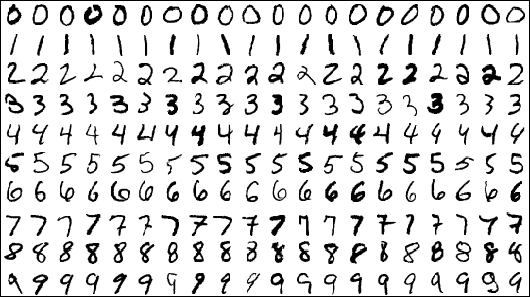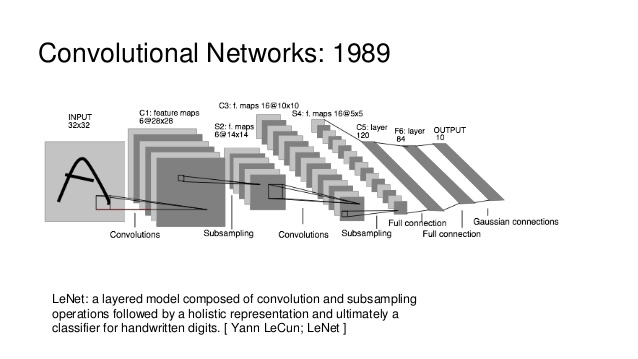DeepLearning¶
MNIST Dataset using DeepWater and Custom MXNet Model¶
The MNIST database is a well-known academic dataset used to benchmark
classification performance. The data consists of 60,000 training images and
10,000 test images. Each image is a standardized $28^2$ pixel greyscale image of
a single handwritten digit. An example of the scanned handwritten digits is
shown

import h2o
h2o.init()
Checking whether there is an H2O instance running at http://localhost:54321. connected.
| H2O cluster uptime: | 2 hours 6 mins |
| H2O cluster version: | 3.11.0.99999 |
| H2O cluster version age: | 9 hours and 12 minutes |
| H2O cluster name: | arno |
| H2O cluster total nodes: | 1 |
| H2O cluster free memory: | 13.65 Gb |
| H2O cluster total cores: | 12 |
| H2O cluster allowed cores: | 12 |
| H2O cluster status: | locked, healthy |
| H2O connection url: | http://localhost:54321 |
| H2O connection proxy: | None |
| Python version: | 2.7.12 final |
import os.path
PATH = os.path.expanduser("~/h2o-3/")
test_df = h2o.import_file(PATH + "bigdata/laptop/mnist/test.csv.gz")
Parse progress: |█████████████████████████████████████████████████████████████████████████████| 100%
train_df = h2o.import_file(PATH + "/bigdata/laptop/mnist/train.csv.gz")
Parse progress: |█████████████████████████████████████████████████████████████████████████████| 100%
Specify the response and predictor columns
y = "C785"
x = train_df.names[0:784]
Convert the number to a class
train_df[y] = train_df[y].asfactor()
test_df[y] = test_df[y].asfactor()
Train Deep Learning model and validate on test set
def lenet(num_classes):
import mxnet as mx
data = mx.symbol.Variable('data')
# first conv
conv1 = mx.symbol.Convolution(data=data, kernel=(5,5), num_filter=20)
tanh1 = mx.symbol.Activation(data=conv1, act_type="tanh")
pool1 = mx.symbol.Pooling(data=tanh1, pool_type="max", kernel=(2,2), stride=(2,2))
# second conv
conv2 = mx.symbol.Convolution(data=pool1, kernel=(5,5), num_filter=50)
tanh2 = mx.symbol.Activation(data=conv2, act_type="tanh")
pool2 = mx.symbol.Pooling(data=tanh2, pool_type="max", kernel=(2,2), stride=(2,2))
# first fullc
flatten = mx.symbol.Flatten(data=pool2)
fc1 = mx.symbol.FullyConnected(data=flatten, num_hidden=500)
tanh3 = mx.symbol.Activation(data=fc1, act_type="tanh")
# second fullc
fc2 = mx.symbol.FullyConnected(data=tanh3, num_hidden=num_classes)
# loss
lenet = mx.symbol.SoftmaxOutput(data=fc2, name='softmax')
return lenet
nclasses = 10
Here we instantiate our lenet model using 10 classes
mxnet_model = lenet(nclasses)
To import the model inside the DeepWater training engine we need to save the model to a file:
model_filename="/tmp/symbol_lenet-py.json"
mxnet_model.save(model_filename)
# pip install graphviz
# sudo apt-get install graphviz
import mxnet as mx
import graphviz
mx.viz.plot_network(mxnet_model, shape={"data":(1, 1, 28, 28)}, node_attrs={"shape":'rect',"fixedsize":'false'})
The model is just the structure of the network expressed as a json dict
!head -n 20 $model_filename
{
"nodes": [
{
"op": "null",
"param": {},
"name": "data",
"inputs": [],
"backward_source_id": -1
},
{
"op": "null",
"param": {},
"name": "convolution0_weight",
"inputs": [],
"backward_source_id": -1
},
{
"op": "null",
"param": {},
"name": "convolution0_bias",
Importing the LeNET model architecture for training in H2O¶
We have defined the model and saved the structure to a file. We are ready to start the training procedure.
from h2o.estimators.deepwater import H2ODeepWaterEstimator
lenet_model = H2ODeepWaterEstimator(
epochs=10,
learning_rate=1e-3,
mini_batch_size=64,
network_definition_file=model_filename,
# network='lenet', ## equivalent pre-configured model
image_shape=[28,28],
problem_type='dataset', ## Not 'image' since we're not passing paths to image files, but raw numbers
ignore_const_cols=False, ## We need to keep all 28x28=784 pixel values, even if some are always 0
channels=1
)
lenet_model.train(x=train_df.names, y=y, training_frame=train_df, validation_frame=test_df)
deepwater Model Build progress: |█████████████████████████████████████████████████████████████| 100%
error = lenet_model.model_performance(valid=True).mean_per_class_error()
print "model error:", error
model error: 0.0200332124248
A More powerful Architecture¶
the beauty of deeplearning is that we can compose a new model with even more "capacity" to try to get a higher accuracy.
def cnn(num_classes):
import mxnet as mx
data = mx.symbol.Variable('data')
inputdropout = mx.symbol.Dropout(data=data, p=0.1)
# first convolution
conv1 = mx.symbol.Convolution(data=data, kernel=(5,5), num_filter=50)
tanh1 = mx.symbol.Activation(data=conv1, act_type="relu")
pool1 = mx.symbol.Pooling(data=tanh1, pool_type="max", pad=(1,1), kernel=(3,3), stride=(2,2))
# second convolution
conv2 = mx.symbol.Convolution(data=pool1, kernel=(5,5), num_filter=100)
tanh2 = mx.symbol.Activation(data=conv2, act_type="relu")
pool2 = mx.symbol.Pooling(data=tanh2, pool_type="max", pad=(1,1), kernel=(3,3), stride=(2,2))
# first fully connected layer
flatten = mx.symbol.Flatten(data=pool2)
fc1 = mx.symbol.FullyConnected(data=flatten, num_hidden=1024)
relu3 = mx.symbol.Activation(data=fc1, act_type="relu")
inputdropout = mx.symbol.Dropout(data=fc1, p=0.5)
# second fully connected layer
flatten = mx.symbol.Flatten(data=relu3)
fc2 = mx.symbol.FullyConnected(data=flatten, num_hidden=1024)
relu4 = mx.symbol.Activation(data=fc2, act_type="relu")
inputdropout = mx.symbol.Dropout(data=fc2, p=0.5)
# third fully connected layer
fc3 = mx.symbol.FullyConnected(data=relu4, num_hidden=num_classes)
# loss
cnn = mx.symbol.SoftmaxOutput(data=fc3, name='softmax')
return cnn
nclasses = 10
mxnet_model = cnn(nclasses)
model_filename="/tmp/symbol_cnn-py.json"
mxnet_model.save(model_filename)
from h2o.estimators.deepwater import H2ODeepWaterEstimator
print("Importing the lenet model architecture for training in H2O")
Importing the lenet model architecture for training in H2O
model = H2ODeepWaterEstimator(
epochs=20,
learning_rate=1e-3,
mini_batch_size=64,
network_definition_file=model_filename,
image_shape=[28,28],
channels=1,
ignore_const_cols=False ## We need to keep all 28x28=784 pixel values, even if some are always 0
)
model.train(x=train_df.names, y=y, training_frame=train_df, validation_frame=test_df)
deepwater Model Build progress: |█████████████████████████████████████████████████████████████| 100%
error = model.model_performance(valid=True).mean_per_class_error()
print "model error:", error
model error: 0.0111236907698
Visualizing the results¶
%matplotlib inline
import matplotlib
import numpy as np
import scipy.io
import matplotlib.pyplot as plt
from IPython.display import Image, display
import warnings
warnings.filterwarnings("ignore")
df = test_df.as_data_frame()
import numpy as np
image = df.T[int(np.random.random()*784)]
image.shape
(785,)
plt.imshow(image[:-1].reshape(28, 28), plt.cm.gray);
print image[-1]
1
image_hf = h2o.H2OFrame.from_python(image.to_dict())
Parse progress: |█████████████████████████████████████████████████████████████████████████████| 100%
prediction = model.predict(image_hf)
deepwater prediction progress: |██████████████████████████████████████████████████████████████| 100%
prediction['predict']
| predict |
|---|
| 1 |
